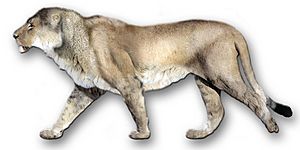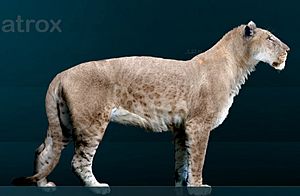American lion facts for kids
Quick facts for kids American lion |
|
|---|---|
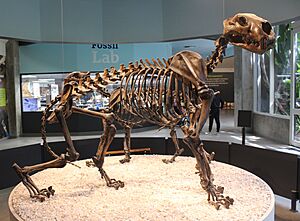 |
|
| Skeleton from the La Brea tar pits at the George C. Page Museum | |
| Scientific classification | |
| Genus: |
Panthera
|
| Species: |
atrox
|
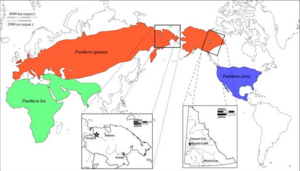 |
|
| The maximal range of cave lions - red indicates Panthera spelaea, blue Panthera atrox, and green Panthera leo. | |
The Panthera atrox, also known as the American lion, was a huge extinct big cat. It lived in North America during the Pleistocene Ice Age, from about 340,000 to 12,800 years ago.
The American lion was first described in 1853 by a scientist named Joseph Leidy. He found a piece of a jawbone in Mississippi. The name 'atrox' means "savage" or "cruel" in Latin. Scientists used to debate if it was a separate species or a type of modern lion. But new genetic tests show it was its own species. It came from the Eurasian cave lion after getting separated in North America.
Fossils of the American lion have been found from Alaska all the way down to Mexico. This amazing cat was about 25% larger than today's lion. This makes it one of the biggest cats ever known!
Contents
Discovery and Evolution
First Discoveries
The first American lion fossil was found in the 1830s in Natchez, Mississippi. It was just a piece of a jawbone. In 1853, Joseph Leidy officially named it Felis atrox, meaning "savage cat." Later, more fossils were found, including skulls in Alaska and many bones in the La Brea Tar Pits in California.
Over time, scientists realized this cat was part of the Panthera group, which includes modern lions and jaguars. So, its name changed to Panthera atrox.
How it Evolved
Scientists once thought the American lion was a type of modern lion or closely related to the tiger. But studies of its DNA from fossils show something different. The American lion (P. atrox) is a close relative of the Eurasian cave lion (Panthera spelaea).
It seems that an early group of cave lions got separated in North America about 340,000 years ago. This separation happened because of huge ice sheets that covered much of the continent. Over time, this isolated group evolved into the American lion. This means the American lion is a unique species that developed right here in North America.
Appearance and Size
The American lion was truly massive! It could measure from 1.6 to 2.5 meters (about 5 to 8 feet) long, not counting its tail. It stood about 1.2 meters (4 feet) tall at the shoulder.
These lions were much heavier than modern lions. Males could weigh between 235 kg and 523 kg (518 to 1153 pounds). Females were also large, weighing from 175 kg to 365 kg (385 to 805 pounds). The largest American lion ever studied weighed about 351 kg (774 pounds).
Their leg bones were very strong, even stronger than those of an African lion. This made them powerful hunters. Many American lion skeletons have been found at the La Brea Tar Pits. These fossils show that they looked a lot like modern lions, but were much bigger.
Some preserved skin from South America suggests the American lion might have had reddish fur. Ancient cave paintings also seem to show them with this color.
Where They Lived
The American lion lived across a wide area of North America. They spread from Alberta, Canada, down to Maryland and as far south as Chiapas, Mexico. They usually preferred open areas like savannas and grasslands, similar to modern lions. They were not often found in thick forests, which were home to jaguars.
They were not found in eastern Canada or the northeastern United States. This might be because of the dense boreal forests (cold, swampy forests) in those regions. Even in cold areas, they likely used caves for shelter. They might have even lined their dens with grass or leaves, just like modern Siberian tigers do.
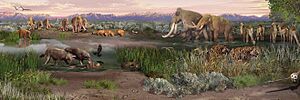
What They Ate
American lions were top predators. They likely hunted large plant-eating animals (called ungulates) such as deer, horses, camels, tapirs, American bison, and even young mammoths.
There's strong proof they hunted bison. A frozen bison carcass found in Alaska, nicknamed "Blue Babe," had clear bite and claw marks from lions. It probably froze before the lions could finish eating it.
Scientists have studied the teeth of American lions. Their teeth show that they were very good at avoiding bones when eating, much like modern cheetahs. This suggests they preferred to eat the meat of their prey.
Extinction
The American lion disappeared along with many other large animals during the Quaternary extinction event about 12,800 years ago. This event caused the extinction of much of the "Pleistocene megafauna" (large animals from the Ice Age).
The youngest American lion fossil found is from Edmonton, Canada. It dates to about 12,877 years ago. Bones of American lions have also been found in the ancient trash heaps of early Native Americans. This suggests that hunting by humans might have played a part in their extinction.
See Also
 In Spanish: León americano para niños
In Spanish: León americano para niños




